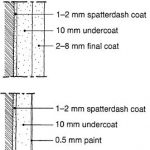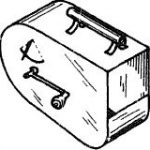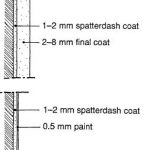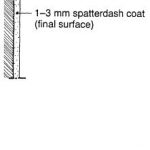The rendering system is determined by the background material, anticipated stress and aesthetics. The number of coats in the rendering varies. The simplest is just one coat, and normally the maximum is three. A basic principle in building up the rendering is that the strength of each layer is less as one moves outwards.
The thickness of the rendering is determined by, among other things, the evenness of the background and the surface desired. If the background is relatively uneven, such as ordinary brickwork, and the surface is to be smooth, it is necessary to have a total thickness of 10–15
mm.
The thickest rendering consists of three coats: spatterdash coat, undercoat and final coat.
Fig. 2: three coat rendering

A spatterdash coat is applied to the substrate surface to control and even distribute the absorbency of the background.
If the backgrouerdash coat (a wet, rich mixture of cement and sand or a “slurry” mixed in the cement to sand ratio of 1:1.5 or 1:3) is thrown hard or spattered against the smooth block or concrete substrate surface using a spatterdash apparatus (Fig.3) and the spattered slurry is allowed to harden. A spatterdash with a special composition that thoroughly wets the background will reduce absorbency enough that the undercoat in turn will wet the spatterdash coat.
Fig.3: a spatterdash apparatus

If the background has extremely high absorption, there is a risk that “normal” render will not wet it sufficiently for the render to adhere to the substrate background.
If the background has little or no absorbency, the plaster will slide off due to its own weight and gravity. It is in cases like these that a spatterdash coat is used to increase absorbency, which makes the succeeding steps easier.
The absorbency of the background can vary greatly on the same facade e.g. between masonry units and mortar. Using a single coat on such a facade means that the characteristics of the finish will vary and, perhaps, later show a rectangular pattern. A spatterdash coat will largely eliminate these effects.
The spatterdash coat should be 1–2 mm thick and unbroken.
The undercoat primarily fills unevenness in the background and provides the desired flatness to the surface. It is also the background for the final coat, and provides an even suction for it. The undercoat is normally 8–12 mm thick.
The final coat is the visible layer of the finished rendering e.g. paint or a coloured plaster.
Fig.4: two coat rendering

For an even thinner cover, one could use just a spatterdash coat and paint. The simplest rendering is just one coat, such as a coloured render (Fig.5).
Fig.5: one coat rendering
